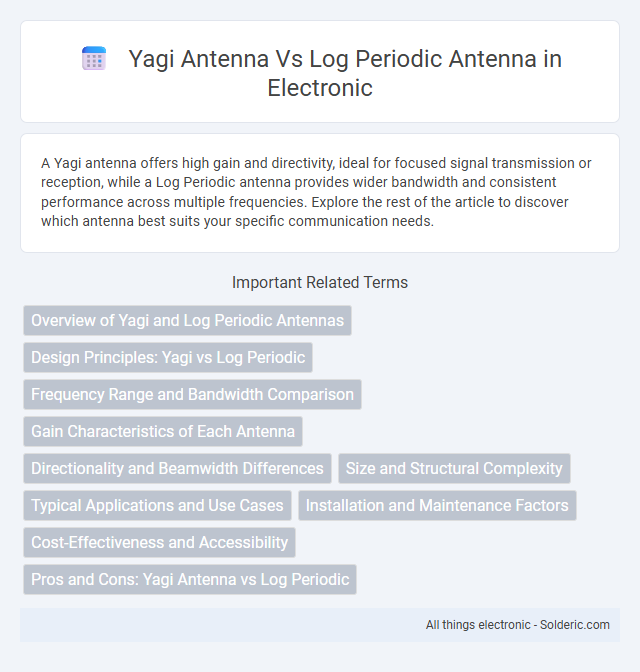A Yagi antenna offers high gain and directivity, ideal for focused signal transmission or reception, while a Log Periodic antenna provides wider bandwidth and consistent performance across multiple frequencies. Explore the rest of the article to discover which antenna best suits your specific communication needs.
Comparison Table
| Feature | Yagi Antenna | Log Periodic Antenna |
|---|---|---|
| Design | Fixed element lengths and spacing | Variable element lengths and spacing |
| Frequency Range | Narrowband (single frequency or small range) | Wideband (broad frequency range) |
| Gain | High gain at designed frequency | Moderate gain over wide frequencies |
| Bandwidth | Limited bandwidth | Wide bandwidth |
| Directivity | High directivity | Moderate directivity |
| Applications | TV reception, ham radio, point-to-point links | Signal scanning, spectrum monitoring, broadband reception |
| Impedance | Typically around 50 ohms | Relatively constant impedance over frequency |
| Complexity | Simple construction | More complex design and construction |
Overview of Yagi and Log Periodic Antennas
Yagi antennas consist of a driven element, reflector, and multiple directors arranged linearly to provide high gain and narrow beamwidth, making them ideal for point-to-point communication. Log periodic antennas feature a series of elements with gradually varying lengths and spacing, offering wide bandwidth and moderate gain suitable for multi-frequency applications. Both antenna types use directional radiation patterns but differ in frequency agility and design complexity.
Design Principles: Yagi vs Log Periodic
Yagi antennas use a fixed number of elements with one driven element, several directors, and a reflector to achieve high gain and directivity, making them ideal for specific frequency ranges. Log periodic antennas feature multiple elements of varying lengths and spacing arranged so that different elements are active at different frequencies, providing wideband frequency coverage and consistent performance across a broad spectrum. Your choice depends on whether you need focused gain at a single frequency (Yagi) or versatility across multiple frequencies (Log Periodic).
Frequency Range and Bandwidth Comparison
Yagi antennas typically operate within a narrow frequency range, optimized for specific frequencies due to their fixed element lengths, providing high gain but limited bandwidth. Log periodic antennas cover a wide frequency range with a broad bandwidth, achieved by gradually varying element lengths and spacing, enabling consistent performance across multiple bands. This makes Yagi antennas ideal for single-frequency applications, while log periodic antennas are preferred for multi-frequency or broadband usage.
Gain Characteristics of Each Antenna
Yagi antennas typically offer higher gain than log periodic antennas, often providing 7 to 20 dBi depending on the number of elements, making them ideal for focused, long-distance communication. Log periodic antennas deliver moderate gain, usually between 6 to 10 dBi, but maintain consistent performance across a wide frequency range, supporting broadband applications. When selecting an antenna for your setup, consider that a Yagi maximizes gain for narrowband use, whereas a log periodic balances gain and frequency coverage for versatility.
Directionality and Beamwidth Differences
Yagi antennas exhibit high directionality with a narrow beamwidth typically around 20 to 40 degrees, making them ideal for targeting specific signals over long distances. Log periodic antennas offer broader beamwidths, generally between 60 to 90 degrees, providing wide frequency coverage and improved signal acquisition from multiple directions. Your choice depends on whether you prioritize focused signal strength (Yagi) or versatile reception across a wide frequency range (Log Periodic).
Size and Structural Complexity
Yagi antennas are typically smaller and simpler in structure, featuring a driven element, reflector, and a few directors, making them easier to install and maintain. Log periodic antennas have a larger physical size with multiple elements of varying lengths and spacing, providing broader frequency coverage but increasing structural complexity. Your choice depends on the balance between the compactness of the Yagi and the versatile bandwidth offered by the log periodic design.
Typical Applications and Use Cases
Yagi antennas are commonly used for television reception, amateur radio, and point-to-point communication due to their high gain and directional characteristics. Log periodic antennas excel in broadband applications such as signal monitoring, scanning, and wideband communication systems because of their consistent performance across a wide frequency range. Both antenna types serve critical roles in wireless communication, with Yagi preferred for narrowband signals and log periodic favored for multi-frequency operations.
Installation and Maintenance Factors
Yagi antennas typically require precise alignment and elevated mounting for optimal performance, making installation more labor-intensive but straightforward due to their fixed directional elements. Log periodic antennas offer broader frequency coverage with moderate gain, requiring less frequent realignment but often involve more complex structural support due to their larger size and weight. Maintenance for Yagi antennas is generally easier given their simpler design, while log periodic antennas demand more attention to joint integrity and element condition because of the multiple resonant elements spanning a wide frequency range.
Cost-Effectiveness and Accessibility
Yagi antennas typically offer greater cost-effectiveness due to their simpler design, fewer elements, and easier manufacturing process, making them more accessible for hobbyists and small-scale applications. Log periodic antennas, while more expensive, provide broader frequency coverage and better performance over a wide bandwidth, justifying higher costs in professional and commercial settings. The availability of Yagi antennas in various sizes and configurations also contributes to their widespread accessibility for diverse use cases.
Pros and Cons: Yagi Antenna vs Log Periodic
Yagi antennas offer high gain and excellent directivity, making them ideal for long-distance communication but have a narrower bandwidth, limiting frequency versatility. Log periodic antennas provide wide bandwidth and stable gain across multiple frequencies, suitable for applications requiring frequency agility, yet they typically have lower gain and a more complex design. Your choice depends on whether you prioritize signal strength and directionality or frequency range and adaptability.
yagi antenna vs log periodic antenna Infographic

 solderic.com
solderic.com